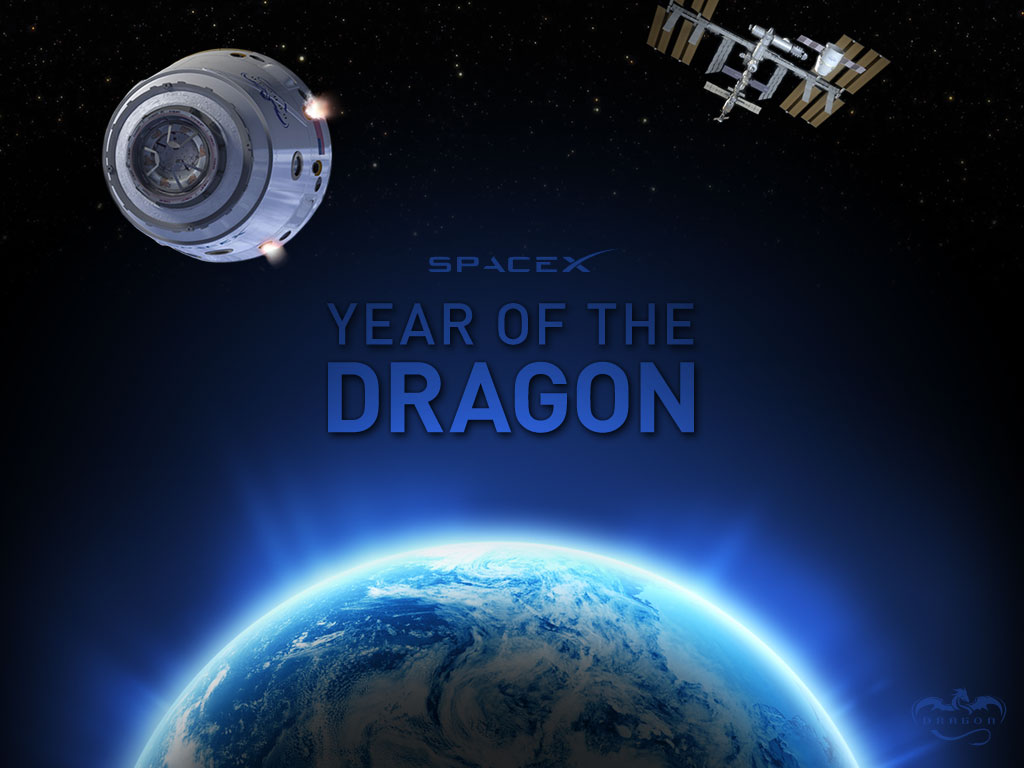Private Rocket Builder Has High Hopes for 'Year of the Dragon'

This story was updated at 4:47 p.m. ET.
The lunar New Year ushered in the "Year of the Dragon" today (Jan. 23), according to the Chinese calendar, with one U.S. rocket company hoping to celebrate with a big fireworks display of its own soon.
The Hawthorne, Calif.-based company Space Exploration Technologies (SpaceX) is putting the finishing touches on its first private spaceship to visit the International Space Station, with the launch now aimed for late March. The gumdrop-shaped capsule is called Dragon and the company has taken a stylized depiction of the mythical beast as a logo.
The company celebrated the Chinese New Year by releasing an interactive panorama of the Dragon space capsule's interior and a digital vehicle and space station above Earth.
"Today marks the start of the Year of the Dragon in the Chinese calendar and this year, SpaceX's Dragon will become the first privately developed spacecraft to visit the International Space Station," SpaceX officials wrote in a statement today. "Space travel is one of the most difficult of all human endeavors, and success is never a guarantee. This flight introduces a series of new challenges and new magnitudes of complexity; if even the smallest thing goes wrong, we will be forced to abort the mission."
Led by veteran entrepreneur Elon Musk, SpaceX is one of two companies contracted by NASA to provide robotic cargo ships to haul supplies to the International Space Station. Musk has said he named the spacecraft "Dragon" after the fictional "Puff the Magic Dragon" in the song by the music group Peter, Paul and Mary because many critics considered the idea impossible when he founded the company in 2002.
Today, SpaceX has a $1.6 billion deal to provide 12 unmanned cargo flights for NASA. The other company — Orbital Sciences Corp., in Virginia — is also planning its first launch to the orbiting lab later this year.
Get the Space.com Newsletter
Breaking space news, the latest updates on rocket launches, skywatching events and more!
SpaceX launched its first Dragon capsule on a short test flight in December 2010 in a historic milestone that marked the first flight and retrieval of a private space capsule. But that flight, which orbited Earth twice before splashing down in the Pacific Ocean, was only a trial run.
The real test will come in March or shortly thereafter, when the first Dragon capsule pulls up to the International Space Station and astronauts aboard the outpost grab it using a robotic arm. [Photos: Dragon, SpaceX's Private Spaceship]
"There will be challenges along the way, but SpaceX will again make history and become the first private company to send a spacecraft to the Space Station," SpaceX officials wrote. "We take this responsibility very seriously and will not stop until we succeed."
SpaceX and NASA originally aimed to launch the Dragon capsule test flight on Feb. 7, but the need for some final tests and checks forced the latest delay, SpaceX officials said.
SpaceX's Dragon capsules can carry about 13,228 pounds (6,000 kilograms) of cargo to low-Earth orbit and are designed to launch atop the company's Falcon 9 rockets. While the capsules can rendezvous with the space station, they are built to be grappled by the space station's robotic arm and attached to an available parking spot on one of the outpost's modules.
SpaceX is also hoping to modify the Dragon capsule to carry up to seven astronauts on trips to and from low-Earth orbit. The company is one of several private spacecraft firms to receive some NASA funds to develop private space taxies capable of ferrying astronauts to and from the space station.
"Dragon is a spacecraft unlike any other," SpaceX officials wrote. "Not only is it the first privately developed spacecraft to successfully return from Earth orbit, but it is also the only reusable spacecraft designed for human transport in operation today."
Like the mythical dragon, SpaceX's capsule does have a pair of wings, but only to generate power. The twin solar arrays are designed to unfold from the capsule after it reaches orbit.
But the spacecraft's solar arrays form just one part of the complicated spacecraft and SpaceX officials pledged to take a closer look at many other systems in the space capsule in the days ahead.
"In the coming days, we'll take a closer look at some of Dragon's advanced technologies in celebration of the Year of the Dragon and the opening of a new era in space travel," they said.
Follow SPACE.com for the latest in space science and exploration news on Twitter @Spacedotcom and on Facebook.
Join our Space Forums to keep talking space on the latest missions, night sky and more! And if you have a news tip, correction or comment, let us know at: community@space.com.

Space.com is the premier source of space exploration, innovation and astronomy news, chronicling (and celebrating) humanity's ongoing expansion across the final frontier. Originally founded in 1999, Space.com is, and always has been, the passion of writers and editors who are space fans and also trained journalists. Our current news team consists of Editor-in-Chief Tariq Malik; Editor Hanneke Weitering, Senior Space Writer Mike Wall; Senior Writer Meghan Bartels; Senior Writer Chelsea Gohd, Senior Writer Tereza Pultarova and Staff Writer Alexander Cox, focusing on e-commerce. Senior Producer Steve Spaleta oversees our space videos, with Diana Whitcroft as our Social Media Editor.









